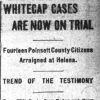calsfoundation@cals.org
Polk County Race War of 1896
In early August 1896, a “race war” broke out between white and Black workers who were working on the Kansas City, Pittsburg and Gulf Railway (later the Kansas City Southern) in both Polk County and near Horatio (Sevier County) to the south. As a result, three African Americans were killed and eight wounded. Although reports place some of the events near Horatio, accounts clearly stated that the purpose of the attack was to keep African Americans out of Polk County, and so it was generally referred to as the Polk County Race War.
This was part of a pattern of labor-related racial intimidation that was sweeping Arkansas at the time. Other incidents during that period included unrest at the Hawthorne Mills southwest of El Dorado (Union County) the following November; at a lumber mill in Canfield (Lafayette County); on the line of the Cotton Belt Railroad in Ouachita County; and at the McNeil (Columbia County) sawmill in December.
According to the August 6, 1896, Arkansas Gazette, the problem in Polk County started on August 5 when a group of thirty Black workers who had gone into the county the week before were run out by enraged citizens. Another carload of African Americans had arrived in Horatio that same day (August 6) on their way to Polk County and were being protected by the sheriff of Sevier County, but trouble was still expected. The report went on to say that “Polk County citizens say they have no negroes there nor will they permit them to come and work on the railroad. The contractors are equally as determined to use negro labor, as it is the best they can do.”
The first known major national coverage appeared in the Salt Lake Herald on August 7. Datelined Texarkana (Miller County), August 6, the article stated that a race war was “imminent” between workers on the Texarkana and Fort Smith Railroad because “the hardy old mountaineers of that section have not allowed any negroes to stop in that section for two years.” As the railroad contractors persisted in hiring Black labor, “the natives have served notice that Sambo must move on, as it is against their religion to permit them to desecrate their soil with pick and shovel or otherwise.” D. J. McDonald, who was the contractor, had hired twenty guards to protect the Black laborers, and they were en route to Horatio to undertake their duties. In the meantime: “The railroad people express their purpose to protect their rights, and as the other side is known to be equally determined, serious trouble is almost certain to follow.”
According to information received from Texarkana, and published in the New York Times on August 10, trouble actually did break out on August 6 despite the guards. Apparently a number of “natives,” accompanied by a mob of Italian, Swedish, and Hungarian workers, had raided the Black workers’ camp. (This is typical of the period; in addition to ingrained racial prejudice, Black workers faced increasing pressure from the waves of foreign immigrants who were entering the United States, and the workforce, during this era.) As a result, three unidentified Black workers were dead and eight wounded. Several leaders of the attack had already been arrested. In the meantime, many African Americans were leaving the county: “Several negroes have passed through this place [Texarkana] who were forced to leave the county, and they bring news of a pretty bad condition of affairs.”
The next day, the Saint Paul Globe reported that, while it was difficult to obtain details on the situation because of the reticence of the “railroad people,” more trouble was anticipated, because the railroad contractors were determined to import Black labor and were planning to bring in another gang. Whether there were further incidents is unknown.
Racial trouble persisted in Polk County, however, with continued attempts to drive African Americans from the Mena (Polk County) area. Nonetheless, African Americans established a small Black community named Little Africa just east of town. This was followed by continued harassment, and even a lynching in 1901. That, combined with the fact that the railroad shops had moved and employment opportunities had fizzled, caused African Americans to leave Mena. The Black population fell from 152 in 1900 to only nine in 1920. This made Mena one of a number of “sundown towns” in the state. Indeed, Polk County itself has a very small African-American population as of the 2010 census, amounting to only 0.3 percent.
For additional information:
“Blacks and Whites.” Salt Lake Herald, August 7, 1896, p. 6.
Lancaster, Guy. “‘There Are Not Many Colored Here’: African Americans in Polk County, Arkansas, 1896–1937.” Arkansas Historical Quarterly 70 (Winter 2011): 429–449.
“Not Wanted in Polk.” Arkansas Gazette, August 6, 1896, p. 1.
“Race War Begun.” Saint Paul Globe, August 9, 1896, p. 5.
“Race War in Arkansas.” New York Times, August 10, 1896, p. 1.
Nancy Snell Griffith
Presbyterian College
 Canfield Race War of 1896
Canfield Race War of 1896 Labor Movement
Labor Movement Night Riders
Night Riders Post-Reconstruction through the Gilded Age, 1875 through 1900
Post-Reconstruction through the Gilded Age, 1875 through 1900 Southern Arkansas Race Riots of Late 1896
Southern Arkansas Race Riots of Late 1896 "Race War in Arkansas"
"Race War in Arkansas" 



Comments
No comments on this entry yet.